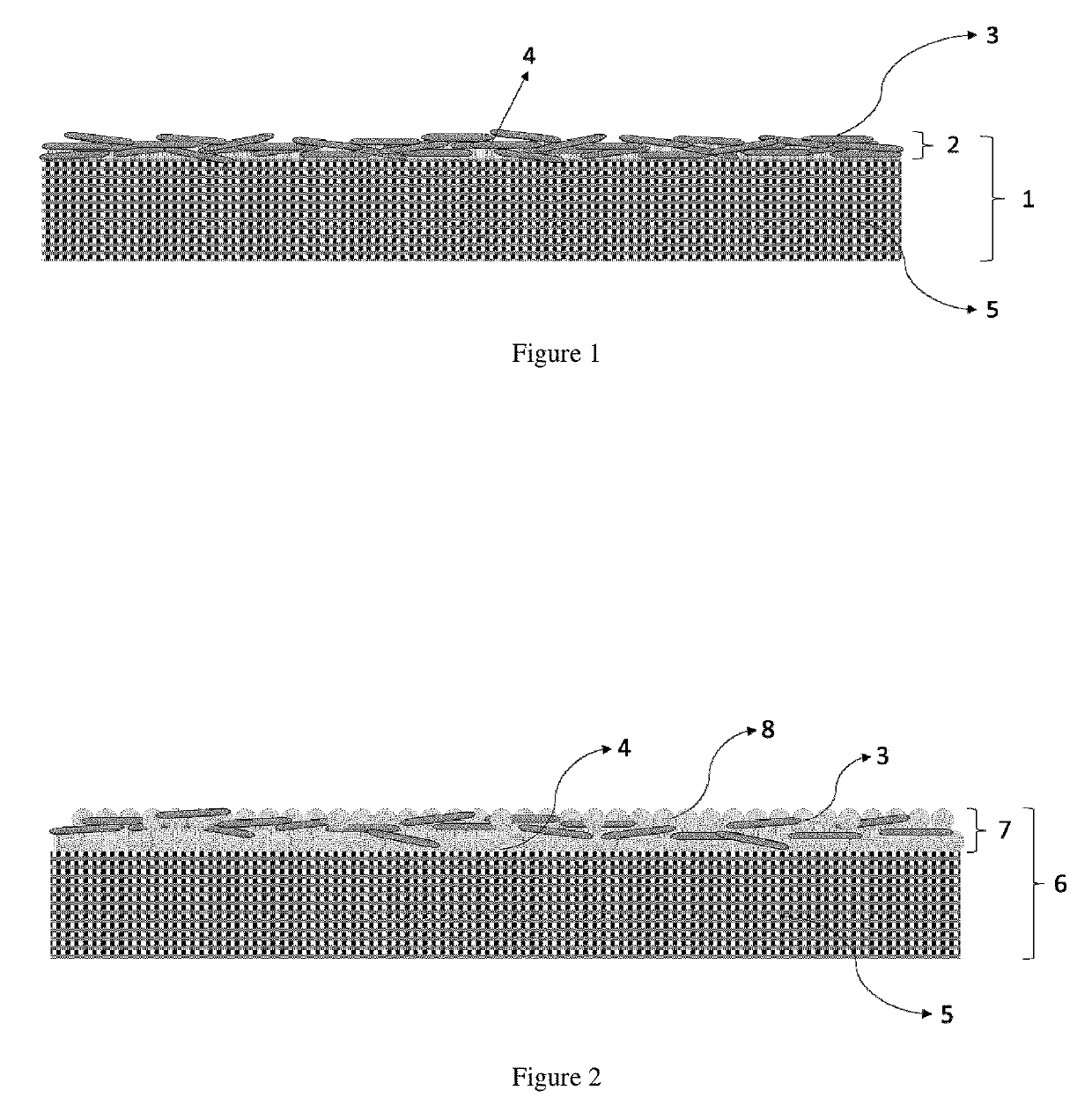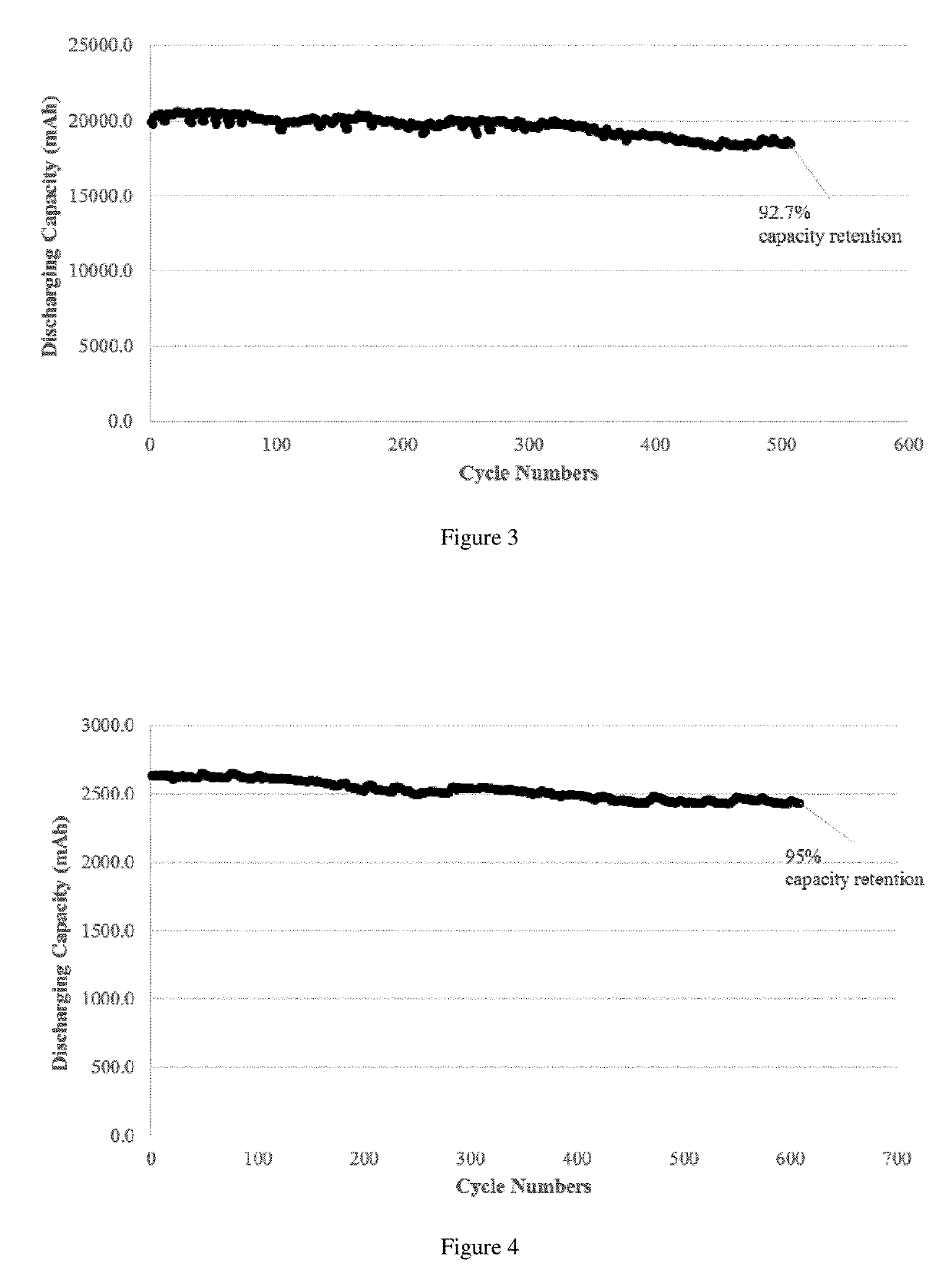Separator for secondary battery
a secondary battery and separator technology, applied in the direction of batteries, sustainable manufacturing/processing, cell components, etc., can solve the problems of battery short circuit, low thermal stability limit, and inability to operate safely
- Summary
- Abstract
- Description
- Claims
- Application Information
AI Technical Summary
Benefits of technology
Problems solved by technology
Method used
Image
Examples
example 1
Preparation of a Separator Coated with a Whisker-Type Material
[0156]An aqueous binder solution was prepared by dissolving 50 g of carboxymethyl cellulose (CMC) (obtained from DAICEL Corporation, Japan; product no. CMC1390) in 6.55 L de-ionized water. To the aqueous binder solution were added 125 g of CaCO3 whiskers (obtained from Jiangxi NP New Materials Technology Co. Ltd., China; product no. NP-CW2) and 7.5 g of styrene butadiene rubber (SBR) (obtained from NIPPON A&L INC., Japan; product no. AL-2001). The whiskers had an average diameter of 0.5 μm and an average length of 8 μm. After the addition, the suspension was stirred for 40 minutes at room temperature at a stirring speed of 50 rpm (revolution per minute) to form a slurry.
[0157]A 30 cm wide nonwoven PET fabric (obtained from MITSUBISHI PAPER MILLS LTD, Japan) having a thickness of about 20 μm and a weight per unit area of about 10 g / m2 was then coated with the above slurry by a continuous roll coater having a doctor blade (...
example 2
Preparation of a Separator Coated with a Whisker-Type Material
[0158]An aqueous binder solution was prepared by dissolving 50 g of CMC in 6.55 L de-ionized water. To the aqueous binder solution were added 105 g of ZnO whiskers (obtained from Hefei Aijia New Material Technology Company Ltd., China) and 7.5 g of SBR. The whiskers had an average diameter of 1 μm and an average length of 11 μm. After the addition, the suspension was stirred for 55 minutes at room temperature at a stirring speed of 50 rpm to form a slurry.
[0159]A 30 cm wide nonwoven PET fabric (obtained from MITSUBISHI PAPER MILLS LTD, Japan) having a thickness of about 20 μm and a weight per unit area of about 10 g / m2 was then coated with the above slurry by a continuous roll coater having a doctor blade. The nonwoven subsequently passed through an oven and dried at a temperature of 100° C. in a hot air stream. The coating speed was in the range of 1.2-1.5 meter / minute. A coating thickness was controlled by an adjustable...
example 3
Preparation of a Separator Coated with a Mixture of Whisker-Type and Particular-Type Materials
[0160]An aqueous binder solution was prepared by dissolving 55 g of CMC in 6.55 L de-ionized water. To the aqueous binder solution were added 50 g of Al2O3 particles (obtained from Taimei Chemicals Co. Ltd., Japan; product no. TM-100), 65 g of K2TiO3 whiskers (obtained from Shanghai Dian Yang Industry Co. LTD, China), and 8.0 g of SBR. The particles had an average diameter of 6 μm. The whiskers had an average diameter of 0.6 μm and an average length of 12 μm. After the addition, the suspension was stirred for 60 minutes at room temperature at a stirring speed of 50 rpm to form a slurry.
[0161]A 30 cm wide nonwoven PET fabric (obtained from MITSUBISHI PAPER MILLS LTD, Japan) having a thickness of about 20 μm and a weight per unit area of about 10 g / m2 was then coated with the above slurry by a continuous roll coater having a doctor blade. The nonwoven subsequently passed through an oven and d...
PUM
| Property | Measurement | Unit |
|---|---|---|
| angle | aaaaa | aaaaa |
| length | aaaaa | aaaaa |
| diameter | aaaaa | aaaaa |
Abstract
Description
Claims
Application Information
 Login to View More
Login to View More - Generate Ideas
- Intellectual Property
- Life Sciences
- Materials
- Tech Scout
- Unparalleled Data Quality
- Higher Quality Content
- 60% Fewer Hallucinations
Browse by: Latest US Patents, China's latest patents, Technical Efficacy Thesaurus, Application Domain, Technology Topic, Popular Technical Reports.
© 2025 PatSnap. All rights reserved.Legal|Privacy policy|Modern Slavery Act Transparency Statement|Sitemap|About US| Contact US: help@patsnap.com


